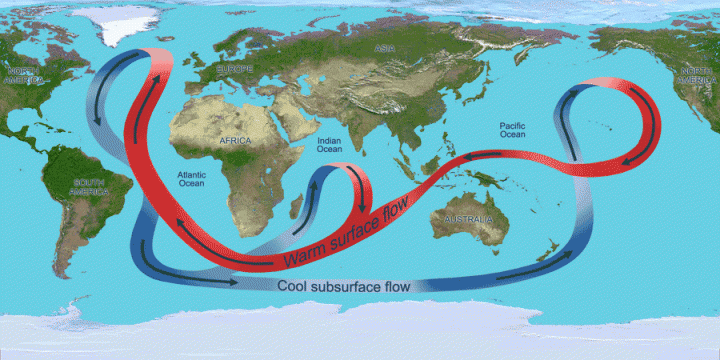Deep ocean currents, referred to as thermohaline currents, are caused by density differences. Colder, saline water masses are more dense and sink; while warmer, fresher water masses are less dense. Warmer water masses are found near equatorial regions and colder water masses are found near polar regions. Less saline water is found where there is more precipitation or river input. More saline water masses are found in areas where there is a lot of evaporation because salt is left in the water, or in polar areas because as ice forms, salt is left in the water. Accordingly, the most dense ocean water – water with the lowest temperature and highest salinity – is found in the North Atlantic Ocean.
This cold, saline water sinks because of its greater density. It then flows southward deep along the ocean floor of the Atlantic Ocean through the Indian Ocean, eventually mixing with the surface currents in the Pacific Ocean. The surface current flows back throughout the Indian Ocean into the Atlantic Ocean, returning surface water to the North Atlantic Ocean and driving the Gulf Stream The Gulf Stream flows along the east coast of the United States and across the northern region of the Atlantic Ocean, causing Great Britain and Europe to have fairly moderate temperatures.
The thermohaline ocean currents have a strong effect on Earth’s climate. This “conveyer belt” type circulation moves heat around the Earth. Scientists do not completely understand this flow of water, but they think that the influx of freshwater into the North Atlantic Ocean causes a disruption to the flow. This freshwater is less dense and would not sink, causing the global flow of ocean water to slow, drastically changing Earth’s climate. Scientists think that if the conveyor slows or stops, the warmer surface water would not be propelled back toward the north Atlantic through the Gulf Stream. This could cause Europe to have colder climates.
The last major glacial climate began about 27,000 years ago and reached its peak about 20,000 to 18,000 years ago. At that time, glaciers of several kilometers in thickness, covered large areas of Europe and North America, reaching as far south as New York and the Ohio River Valley. The temperatures in Greenland were 10°C (18°F) lower than today and tropical temperatures were 4°C (7°C) lower. Because so much water was in the form of ice over land, sea level was about 120 m (395 ft) lower than it was today. Scientists think that the last glacial period ended because two orbital cycles synchronized to cause warmer summers across the Northern Hemisphere.
About 18,000 years ago, the planet entered an interglacial (warming) period until about 13,000 years ago when the average temperature suddenly dropped and northeastern North America and northern Europe reverted back to glacial conditions. To review, the Greenland ice cores reveal this abrupt 1,300- year return to glacial conditions until about 11,600 years ago. About 11,600 years ago, the temperature in Greenland rapidly rose by 7°C (13°F) in over a few decades or less, marking the ending of the Younger Dryas and beginning of the Holocene epoch. For the past 8,000 years, the Vostok and Greenland ice core records indicate that Earth’s climate has been in an unusually stable.

